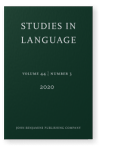Vol. 44:3 (2020) ► pp.606–658
Possessive and non-identity relations in Turkic switch-reference
This paper provides an overview of non-canonical patterns of switch-reference involving the converb in -(V)p in selected Turkic languages. This converb is usually described as a same-subject converb, but we show that it can conform to McKenzie’s (2012) extended definition of “same-subject” as expressing the identity of topic situations, rather than subject referents. In addition to tracking cross-clausal subject identity, -(V)p can be used when the possessor of the subject of one clause corefers with the subject of another clause and when the events expressed by the two clauses are in a close temporal and/or causal relationship. Based on Stirling (1993) and Bárány & Nikolaeva (2019), we argue that the role of possessors in Turkic switch-reference is captured by lexically specified conditions licensing the use of -(V)p when two subjects are in a possessive relation. Finally, we suggest that both types of non-canonical switch-reference can be seen as ensuring discourse continuity.
Article outline
- 1.Introduction
- 2.Converbial structures
- 3.Same-subject constructions
- 3.1Old Turkic
- 3.2Eastern Turkic
- 3.3Western Turkic
- 4.Different-subject constructions
- 4.1Different-subject constructions and clausal linking
- 4.2Languages with marginal different-subject constructions
- 4.3Possessive relations between different subjects
- 5.Licensing conditions of Turkic switch-reference
- 5.1Licensing conditions
- 5.2Part-whole relations and action continuity
- 5.3Alienable possession as participant continuity
- 6.Summary and other issues
- Acknowledgements
- Notes
- Abbreviations
-
References
